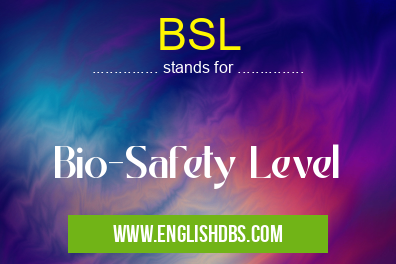What does BSL mean in LABORATORY
Bio-Safety Level (BSL) is a system used to categorize biological agents and practices according to the risks they pose. It is used by research institutions, government agencies and laboratories to determine appropriate practices and safety measures for working with potentially infectious materials. BSL helps protect people from exposure to hazardous materials, providing guidelines for handling and disposing of them safely.

BSL meaning in Laboratory in Medical
BSL mostly used in an acronym Laboratory in Category Medical that means Bio-Safety Level
Shorthand: BSL,
Full Form: Bio-Safety Level
For more information of "Bio-Safety Level", see the section below.
» Medical » Laboratory
Essential Questions and Answers on Bio-Safety Level in "MEDICAL»LABORATORY"
What are the 4 levels of bio-safety?
The four levels of bio-safety range from BSL-1(basic laboratory safety) to BSL-4 (maximum containment) with increasing security protocols based on the following characteristics - Risk factors, Treatment methods, Personnel protection and Containment facilities.
What type of organisms does each Bio-Safety level cover?
BSL-1 covers any organism that is not known to cause disease in healthy humans; BSL-2 covers any organism that can cause moderate illness in humans; BSL-3 covers any organism that can potentially cause serious or lethal disease in humans; and BSL-4 covers any agent assigned by government officials as posing a high risk of causing severe or fatal disease in humans.
What type of safety equipment should be used when handling Biohazardous materials?
Safety equipment will depend on the Bio Safety level being worked with but may include gloves, laboratory coats or gowns, eye protection (e.g., face shields or goggles), respirators, foot protection (preferably closed toe shoes) and disposable aprons. Appropriate waste disposal containers should also be provided when working with biological hazard materials.
Who is responsible for setting up containment strategies?
The institution where the research will be conducted is responsible for setting up containment strategies and implementing appropriate safety measures according to the biohazard classification of the material being handled. This includes establishing procedures such as warning signs, access restrictions and emergency plans.
Are there any legal requirements concerning biohazards?
Yes, national regulations must be followed when handling biohazardous materials including registration requirements for laboratories dealing with infectious agents and adherence to specific safety standards set out by authorities.
Final Words:
Bio-Safety Level (BSL) provides an important framework for ensuring safe laboratory environments when working with potentially hazardous biological agents. Following this system helps minimize public health risks by providing instructions on how dangerous material should be handled, disposed off properly adhering to relevant legal requirements.
BSL also stands for: |
|
| All stands for BSL |
